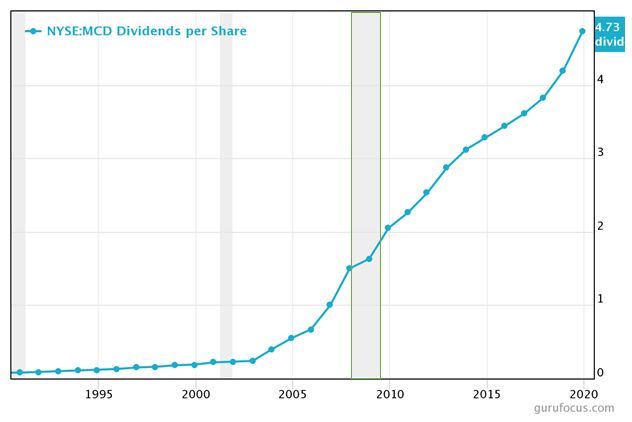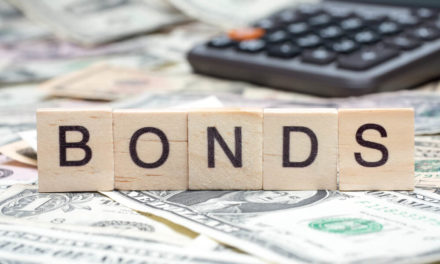High dividend yields are seductive.
They can also be a siren song for income investors who buy in, only to get crushed when the high yields prove to be a value trap.
Of course, not all high yields are a warning sign, and I regularly recommend high-yielders.
Oftentimes, though, a huge dividend is one that’s about to get slashed.
So, instead of finding a payout that could get shredded, let’s look at a company with a long history of raising its dividend.
Over the course of retirement, dividend growth is more important than raw yield. It’s the only way to ensure your income stream stays ahead of inflation.
Think about it. Let’s say you got a great job right out of school that paid well … but your employer never gave you a raise.
That paycheck would lose its appeal as your living expenses rose.
You’d be better off taking a job that offered modest pay on day one but had the potential for a lifetime of healthy raises.
And McDonald’s Corporation (NYSE: MCD) falls into the latter category.
A Quick Look at McDonald’s Dividend
At current prices, McDonald’s dividend yields 2.3%. I know that isn’t a high yield by any stretch of the imagination.
Since declaring its first dividend in 1976, McDonald’s has raised its dividend every single year.
It is, however, competitive with other income investments in this era of low yields. It’s more than double the yield you’d get on a 10-year Treasury and roughly in line with the yields on 10-year A-rated bonds.
But, again, I’m more interested in growth than raw yield. And this is where McDonald’s shines like those golden arches on a dark drive home.
Since declaring its first dividend in 1976, McDonald’s has raised its dividend every single year. And it shows no sign of slowing down.
MCD: Decades of Healthy Dividend Growth

You can see in the chart above that McDonald’s dividend growth has been especially strong in the last decade. And the fast-food giant still managed to grow its payout during the recession of 2008 (gray shaded area).
McDonald’s hiked its dividend by about 8% last year. Over the past three years, the dividend has grown at a compound annual rate of 9%. And over the past decade, McDonald’s has grown its dividend at a compound annual rate of 8%.
Like Getting a Raise Every Year
Only time will tell whether we can expect 8% to 9% dividend growth every year until the end of time.
But I can say with confidence that McDonald’s has successfully adapted to changing tastes over the decades. And I have no reason to believe that will change any time soon.
If you want to be conservative, you might model more modest dividend growth of 5% to 6% going forward. But it’s safe to assume that the dividend checks will keep growing over the course of your retirement — and likely at levels far above the rate of inflation.
Yield on Cost Proves McDonald’s Dividend Value
Let’s take a look at one of my favorite dividend metrics: yield on cost. To get to this number, divide the current annual dividend by your original purchase price. At its core, yield on cost is a measure of cash-on-cash return.
If you had bought McDonald’s stock five years ago, the dividend today would represent a 3.2% yield. That’s not get-rich-quick money, but it’s solid.
Let’s say you bought McDonald’s 10 years ago. Your yield on cost would be 4.9%. If you had picked up McDonald’s stock 20 years ago, your yield on cost would be an impressive 17%.
That’s the power of dividend growth.
McDonald’s has had its share of controversies. Former CEO Steve Easterbrook was terminated last year after trying to cover up an inappropriate workplace relationship.
But the beauty of the company is that its business model is simple enough to run itself on autopilot for years if needed.
McDonald’s doesn’t rate all that high on our Green Zone Ratings system at the moment. Its low ratings in size, value and growth pull it down. McDonald’s is a large, slow-growth company.
It’s worth noting that McDonald’s scores exceptionally high on volatility (meaning it’s a low-volatility stock) and rates well on quality. These are qualities we want in a long-term dividend payer, if not necessarily in a short-term trade.
So, if you’re looking for a dividend stock to last you through a long retirement, supersize an order of McDonald’s stock. But we shouldn’t expect a lot of capital gains, or at least not immediately. Think of McDonald’s more as a hamburger-selling bond with a rising payout.
Money & Markets contributor Charles Sizemore specializes in income and retirement topics. Charles is a regular on The Bull & The Bear podcast. He is also a frequent guest on CNBC, Bloomberg and Fox Business.
Follow Charles on Twitter @CharlesSizemore.





